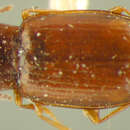Comprehensive Description
provided by Smithsonian Contributions to Zoology
Tachyta falli (Hayward)
Tachys falli Hayward, 1900:199 [lectotype, male, MCZ, designated by Erwin, 1974b: 150, type-locality: Siskiyou County, California].
Tachyta falli (Hayward), Erwin, 1974b: 150.
DIAGNOSIS.—The elytral chaetotaxy (Ed 6 in position a, Ed 3 located on a plane slightly behind Eo 4), shallowly rugose elytral surface and constriction of elytral interval 4 at Ed 3 are distinctive in the genus.
DESCRIPTION.—Form (Figure 96): Very broad, elongate and depressed; head broad and only slightly convex with small, moderately prominent eyes.
Color: Moderately shiny rufopiceous or piceous, elytral usually paler than head and pronotum; appendages flavotestaceous, penultimate article of maxillary palp infuscated.
Head (Figure 102): Broad and only slightly convex, slightly narrower across eyes than width of pronotum across anterior angles; frontal furrows very shallow and poorly defined, lateral carina low and not well developed, anterior supraorbital seta located in deep fovea; front between eyes sparsely and finely punctulate, punctulae not arranged in transverse band but more or less grouped mesad to carina between supraorbital setae; eyes small and moderately prominent. Mentum (Figure 101) less sulcate than in T. subvirens members, with buccal fissure complete, and submentum with very small and shallow sulcus.
Pronotum (Figure 103): Transverse, disc flat medially and only slightly convex laterally; sides straight or slightly sinuate posteriorly, margins narrowly beaded, not reflexed, surface laterobasally strongly carinate, carina short; hind angles about 90°; basal transverse impression well engraved laterally, broadly interrupted medially, and not confluent with strongly impressed median line; anterior angles moderately prominent, not produced.
Elytra (Figures 104, 105): Suturai interneur entire, striate and well impressed throughout, interneurs 2 to 6 moderately well impressed and ended at about apical third, interneur 7 effaced, interneur 8 sulcate anteriorly and posteriorly, effaced at middle; humeral margin rounded to base of interneur 5, margin broadly reflexed and explanate from humerus to plica, edge finely setulose behind humerus; chaetotaxy as in T. nana; plica well developed and visible externally.
>
Microsculpture (Figures 108–110): Well impressed, nearly isodiametric microreticulation over entire dorsal surface, meshes mostly forming transverse rows.
Genitalia (Figures 99, 107): Male (Figure 99) with internal sac complex, phallus with apex attenuate (5 examined); female (Figure 106, 107) (5 examined).
Size: Length, 2.60 to 3.24 mm; width, 1.10 to 1.44 mm, 8 specimens measured.
VARIATION.—The color as discussed above varies with age of the specimen. In addition, the shape of the pronotum varies in degree of sinuation posterolaterally, from straight to moderately sinuate. In the latter type, the beetles resemble T. nana kirbyi members and are often mixed in collections. However, the roughened elytra and constricted fourth interval are distinctive.
NATURAL HISTORY.—Adults have been found from April to September; teneral adults were found in July and August. It is quite likely that hibernation takes place in the adult stage. Larvae can be found probably in early summer. Elevation record indicates an altitudinal range from near sea level in the California Coast Range to 2300 m in the Sierra Nevada. Many specimens were found under bark of Pinus ponderosa and Abies magnifica by my wife and me at 2150 m elevation near Chester, California. These beetles were also found under bark of Pseudotsuga menzieii in British Columbia (Lindroth, 1966) and “In rotten Balsam log” (label on specimen from Vancouver Island, British Columbia). This “Balsam log” was probably Abies balsamea.
DISTRIBUTION (Figure 111).—The range of this species is confined to the Pacific Northwest from southwestern British Columbia south to Fresno and Tulare counties, California, and east to Idaho. The species is known from the Coast Ranges, Cascades, and Sierra Nevada.
- bibliographic citation
- Erwin, Terry L. 1975. "Studies of the subtribe Tachyina (Coleoptera: Carabidae: Bembidiini), Part III: Systematics, phylogeny, and zoogeography of the genus Tachyta Kirby." Smithsonian Contributions to Zoology. 1-68. https://doi.org/10.5479/si.00810282.208
Tachyta falli: Brief Summary
provided by wikipedia EN
Tachyta falli is a species of ground beetle in the family Carabidae. It is found in North America.
- license
- cc-by-sa-3.0
- copyright
- Wikipedia authors and editors

